Originally published in the Los Angeles Times on September 4, 2014.
The concept of “secular stagnation” — that the economy may be facing a protracted period of low growth and high unemployment — has been seeping back into economic and policy discourse. Once relegated to the margins of heterodox economic theory, the idea of stagnation as a likely ongoing direction for the economy, in fact, is now virtually mainstream, expounded by such well-known figures as Lawrence Summers and Paul Krugman.
Major economic floundering in the first quarter of the 20th century was relieved by the boost World War I gave to the economy, and the tremendous economic collapse in the second quarter was ended by World War II’s huge increase in military spending. In the third quarter, the Korean War, the Cold War and the Vietnam War added major stimulus at key times.
According to the projections, the OECD member nations’ annual average contribution to global GDP growth will steadily fall from 1.19% this decade to 0.54% between 2050 and 2060. Meanwhile, inequality in these countries may rise as much as 30% or more.
The OECD projections are, if anything, optimistic, since they assume that Europe and the United States each will absorb in the neighborhood of 50 million new immigrants over this period — an assumption that may run contrary to the restrictive politics of immigration playing out on both sides of the Atlantic.
The economic remedy for stagnation is relatively straightforward — in theory: Faltering demand could be offset by large-scale government spending on infrastructure, education and other much-needed investments. In practice, however, it is painfully clear that large-scale Keynesian policies of this kind are no longer politically viable.
The implications of the emerging possibility of a sustained period of stagnation are profound. Through the repeated economic downturns of recent U.S. history — 11 since 1945 alone — the expectation of eventual sustained recovery has been the critical assumption underpinning both politics and policy. An era of stagnation would undermine the economic basis of traditional political hope of both left and right. It would mean ongoing high unemployment, ongoing deficits, ongoing struggles to fund public programs and, in all probability, ongoing and intensified political deadlock and wrangling as unemployment continues, deficits increase and a profound battle over narrowing economic possibilities sets in.
If stagnation is the new normal, we will likely be forced to reassess the fundamental assumptions of politics and the economy and to ultimately get serious about restructuring our faltering economic system in more far-reaching ways than most Americans have contemplated.
 AMERICA BEYOND CAPITALISM
AMERICA BEYOND CAPITALISM



 Agenda
Agenda  Posterboard
Posterboard 